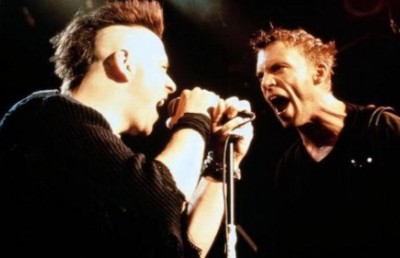The Objectification of Jennifer Lawrence in Contemporary Hollywood Cinema
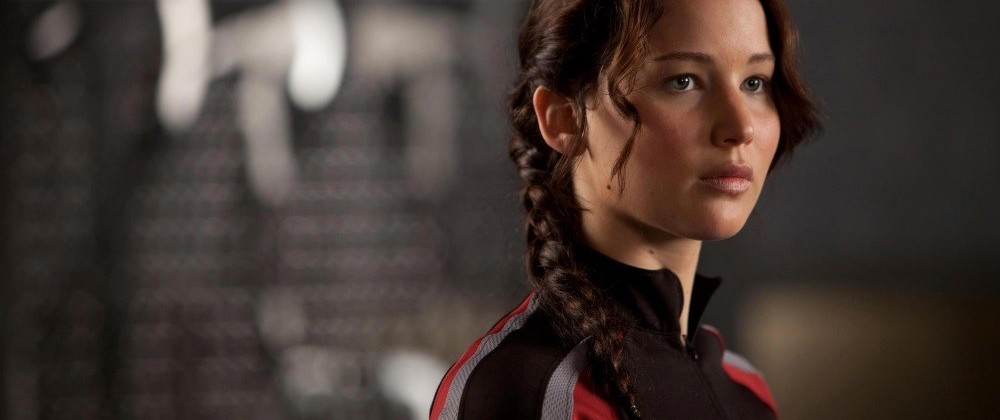
Christine Gledhill describes U.S. film stars as ‘… a product of mass culture …’ (Gledhill, xiii) and Alexander Walker believes they are ‘… the direct or indirect reflection of the needs, drives and dreams of American society’ (Walker, xi). The word ‘product’ conveys a sense of dehumanisation with regards to the star and creates the impression of an item to be consumed and treated ‘merely as an object rather than a person’ (Soanes and Hawker, 698). The objectification of stars in mass culture is suggested as being a form of wish fulfilment and an aspiration for society by Walker. I will explore these ideas in relation to popular contemporary Hollywood star Jennifer Lawrence, examining how The Hunger Games (Gary Ross, 2012) and Silver Linings Playbook (David O. Russell, 2012) seek to objectify the actress whilst analysing the effect this has on both the motion pictures and Lawrence’s star persona. An important distinction to make is that the films objectify the actress for different reasons; The Hunger Games is focused on reinforcing the image of Lawrence as a heroine following the success of her Oscar nominated performance in Winter’s Bone (Debra Granik, 2010) whilst thematically making comments on society, reality television and consumer culture through the way she is presented at various points within the film. In contrast, Silver Linings Playbook places emphasis on Lawrence’s sexuality and physical appearance as well as attempting to subvert genre conventions and audience expectations of the typical romantic comedy through aspects of her performance. By creating a distinction between the different modes of objectification operating in the two films, one can see more clearly the effect each film is trying to achieve through the utilisation of Lawrence.
The Hunger Games is the first film of a blockbuster franchise, a blockbuster being defined as a film with ‘… an extremely high production and marketing budget that attains considerable commercial success’ (Kuhn and Westwell, 37). Thomas Elsaesser goes further when describing the Hollywood blockbuster and suggests ‘Each aspect of the film – the clothes the actors wear, the props and accessories … – can give rise to further economic activity: lines in fashion, toys, product placement, tourism …’ (Elsaesser, 287) consequently attaching a significant level of objectification to the film as a product before even beginning to focus on the use of the stars within the motion picture. As previously stated, the objectification of Jennifer Lawrence within the context of The Hunger Games is knowingly done so, to reflect the thematic elements present in the film and also to reinforce the brave and gritty image of the star created by her earlier films. On one hand, the film is concerned with the binary oppositions between the two significant locations featured within the film – District 12 and the Capitol. These distinctions separate the authentic from the false and therefore appear to be making a critical statement regarding the characters that inhabit the false world of the Capitol, instead positioning the viewer to support the authentic District 12.
In his seminal work The Country and the City, Marxist literary critic Raymond Williams writes of the disparity between country and city life stating ‘… the country has gathered the idea of a natural way of life: of peace, innocence, and simple virtue’ (Williams, 339). Williams then contrasts this with his description of the city as ‘… a place of noise … and ambition …’ (Williams, 339) depicted in the array of manipulated spaces and images found within the Capitol in The Hunger Games, such as the artificiality of the television studio and the extravagant hairstyles worn by many characters. Because of this, the film frequently borders on becoming a satire of modern times and occasionally derives humour from the actions and visual appearance of characters, such as Effie Trinket (Elizabeth Banks), when compared to the poverty-stricken image presented by Katniss (Jennifer Lawrence) in District 12. Lawrence is clearly objectified once she enters into the Capitol, however it isn’t in an overtly sexualised manner and instead relates to the aforementioned contrasts between the authentic and the false presented within the picture. Her objectification as a reality television star is used to comment upon our society by revealing the Capitol’s ability to pin their wishes and aspirations on carefully crafted idols. This echoes the statement by Alexander Walker regarding film stars and corresponds with Richard Dyer’s discussion of stars as ‘… a manifestation of the one-dimensionality of advanced capitalist society …’ (Dyer, 14 – 15), highlighting the similarities between our world and that of the Capitol.
Having discussed the purpose of Lawrence’s objectification as ironic and satirical within The Hunger Games, it is important to examine how the film objectifies her and analyse the cinematic techniques utilised to achieve this. After arriving in the Capitol, a montage shows her being given a makeover for the television cameras. This draws attention to glamour being used as a marketing tool; a similar concept within the film is that of the sponsors – popularity within the contest can guarantee help for the tributes within the game. The survival of a human life being reliant on money and public interest acts as a metaphor for society’s treatment of stars whilst Lawrence’s objectification within the film as a facade for reality television mirrors the celebrity status held by Lawrence as a fashionable Hollywood star in modern popular culture.
The scene most illustrative of these themes which also serves as an example of Lawrence’s objectification is the parade of the tributes where Katniss and Peeta (Josh Hutcherson) enter on a chariot wearing flaming outfits. This is the first time Katniss has made a public appearance since entering the Capitol and naturally, the emphasis is placed on her manufactured image. There are several layers of spectatorship evident in this sequence; all of the spectators are scrutinising the tributes and treating them as objects rather than people. Firstly, as a viewer we are positioned to watch this sequence via a reality television show hosted by Caesar Flickerman (Stanley Tucci); Caesar looks into the camera which creates a sense of authenticity regarding the television show and consequently positions us, the viewers, as the consumers who are objectifying Katniss. This technique works on a secondary level as the film could once again be using satire to suggest, in a slightly exaggerated way, that this is the way celebrities are treated in our modern society. In the mise-en-scène behind Flickerman are masses of crowds, acting as further spectators, present to witness the event.
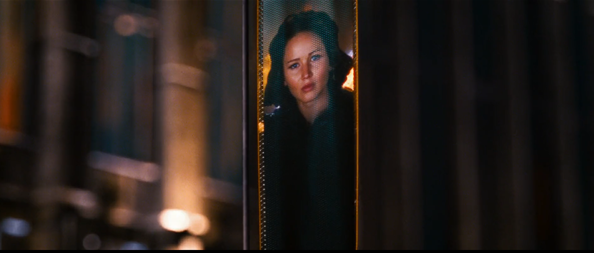
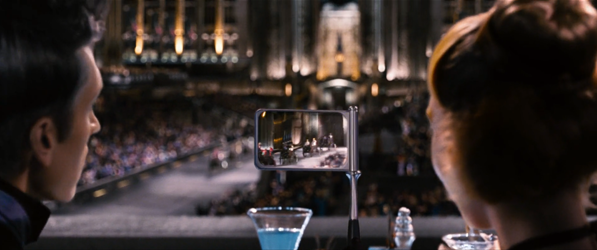
As if to emphasise the theme of objectification, one moment features an over the shoulder shot of a woman with her back to the camera, in focus in the foreground of the frame whilst the tributes in the distance are blurred in the background of the shot. To help her see properly, she holds up a magnifying glass, allowing the tributes in the distance to become clear and in focus when observed through this object. This brief shot epitomises the concept of scrutiny and objectification in the film, stressing the importance of image in a place like the Capitol. It is fitting that the first shot of Katniss’ entrance is an extreme close-up of her face before steadily zooming out to reveal her outfit and the flaming chariot. All these elements within the shot are evidence of her objectification and are not indicative of Katniss’ personality as displayed to the viewers thus far in the film. A rapid, possible point of view shot featuring the crowd cheering for Katniss is followed by another close up of Lawrence displaying a puzzled expression as if she can’t quite comprehend why the masses are responding to her entrance in such a manner. Many shots of the crowd in this sequence last just under a second, overwhelming the viewer in the same way as Katniss. This once again creates the effect of the viewer simultaneously being part of the film and being detached from it; we are part of the crowd and are being shown that this reflects our own culture yet through Lawrence’s performance and aesthetic devices such as rapid editing, we are able to recognise and criticise it.
One of the explanations for the crowd’s excessively enthusiastic reception of Katniss during the parade of the tributes is their fascination with her image and how she is presented. They know nothing about her personality but are clearly interested in her fashion; relating to Dyer’s statement regarding fashion being ‘… the ultimate in manipulation because it is so superficial’ (Dyer, 15). The word ‘manipulation’ suggests a power and control on Katniss’ part; despite her objectification, she remains in control as she is effectively deceiving the Capitol in return for popularity, sponsors and therefore a greater chance of survival in the Hunger Games. Elements of power and control are characteristic of Lawrence’s image prior to the release of The Hunger Games, created and reinforced through her performances in The Poker House (Lori Petty, 2008) and Winter’s Bone as a self-sufficient, tough, athletic teen and the unelected head of a family due to inadequate or absent parents. This representation of Lawrence is repeated during Katniss’ more authentic moments in District 12 at the start of The Hunger Games. Jackie Stacey believes that Hollywood produces ‘… normative models of feminine glamour, whilst on the other hand offering women fantasies of resistance …’ (Stacey, 151) explaining that female stars sometimes present ‘… images of power and confidence’ (Stacey, 151) giving the viewer ‘… fantasies of power outside their own experience’ (Stacey, 151). This is certainly true of the authentic side of Katniss which Lawrence displays throughout The Hunger Games and links with her performance in Silver Linings Playbook, a film which shifts between these ‘normative models’ of glamour and a subversion of genre and character expectations in the Hollywood romantic comedy.
The romantic comedy film is typically described as a ‘… subgenre of the comedy film in which romance is integral and interdependent with comedic elements’ (Kuhn and Westwell, 354). Typical expectations from a film of this genre would be ‘… a lightness of tone and a narrative resolution governed by harmony, reconciliation, and happiness …’ (Kuhn and Westwell, 354) which usually features ‘… a (more often than not) white, heterosexual … couple successfully overcome a series of obstacles’ (Kuhn and Westwell, 354). In Hollywood romantic comedies, the male and female lead roles are usually filled by popular stars and it is not uncommon for them to be objectified, sometimes for the purposes of comedy but frequently, in the case of the female role, ‘… as objects of the “male” gaze’ (Stacey, 143). Silver Linings Playbook can be viewed as a film that is undertaking two completely contrasting ideas simultaneously; whilst it ostensibly seeks to subvert the traits associated with the romantic comedy genre as a consequence of its thematic focus on mental illness, it manages to succumb to almost all of them by its final moments. Lawrence’s performance in the film plays against the glamorous type associated with the leads in romantic comedies; she is emotionally unstable, dresses almost exclusively in black and seems romantically uninterested in the male lead, Pat Solatano, Jr. (Bradley Cooper), for the majority of the film. However, she is also objectified and sexualised in terms of how she is filmed, how other characters interact with her and how her character is changed in the screenplay when compared with the 2008 novel of the same name by Matthew Quick.
Pat and Tiffany’s (Jennifer Lawrence) ‘date’ at a diner in the middle of the film is a perfect example of how O. Russell attempts to subvert romantic cliché’s through the film’s style, screenplay and performances. Additionally, it can be argued that during this scene, the characters are objectified not in a physical or sexual way but instead in a comedic way as a result of their psychological condition. Despite its dramatic moments, exploiting serious themes such as mental illness for comedy has attracted some negative criticism towards the film but is nonetheless relevant to the diner sequence. Firstly, the date is set on Halloween night and the background of multiple shots is littered with children and adults in fancy dress. By setting the date on Halloween, O. Russell is none too subtly drawing comparisons between the freakish outsiders in fancy dress and Pat and Tiffany; viewed as the outsiders in both society and their families as a consequence of their behaviour. Costumes are also important in this sequence with regards to the film’s subversion of romantic comedy expectations; O. Russell uses a variety of techniques to indicate to the viewer that this isn’t a date scene, to the extent that Bradley Cooper’s character states “It’s not a date.” Despite Tiffany making an effort and dressing up for the occasion, Pat wears a sports hoodie and jacket, signifying to the viewer a possible lack of interest and care towards the evening on his part. Clichéd romantic compliments such as “You look nice” are spoken by Pat in a dull, uninterested manner and his fixation on his ex-wife Nikki (Brea Bee) is handled in a comedic way, mainly through Tiffany’s reactions to his obsessive comments about her. Despite the characteristics of Pat and Tiffany partly being products of mental trauma, O. Russell’s screenplay and direction keeps the mood light during this scene and it can be argued that Tiffany’s mental problems are being objectified, as opposed to her sexuality, and used to create moments of comedy.
Despite its attempts at distinguishing itself from other films in the same genre, Silver Linings Playbook is ultimately as genre-defining as any other romantic comedy. This is partly O. Russell’s intention, as an early scene features Pat complaining about Ernest Hemingway’s A Farewell to Arms and arguing that because the real world is so tough, works of fiction should have happy endings. This moment should indicate to the viewer that no matter what happens throughout the course of the film, the two leads will eventually overcome any troubles they might have and become a couple. When viewing the film as a romantic comedy, it is easier to recognise Lawrence’s objectification, not just as someone with psychological problems but also as a sexualised figure, appealing to both the array of male characters within the film and O. Russell’s camera. This objectification of Lawrence is vastly different to the type displayed in The Hunger Games but also embodies elements of her character types from previous films such as the strong, empowered female. The main difference is that in Silver Linings Playbook, the objectification of her character also plays into Lawrence’s glamorous celebrity persona as a sexualised being. In Tiffany’s first scene in the movie, following awkward conversation between herself and Pat, there is a series of point of view shots, arguably designed to hint at Pat’s interest in the character which emphasise a focus on Lawrence’s sexuality in comparison to Lawrence’s portrayal of Katniss in The Hunger Games. Pat’s eyes lower to look at Tiffany’s body and the camera cuts to a close up of Lawrence’s cleavage before panning right to focus on her black painted nails. This image summarises the two different types of film Silver Linings Playbook appears to be; Lawrence is seen as sexual and glamorous to the male lead, but is also dark and troubled, indicated by her clothing and nail polish.
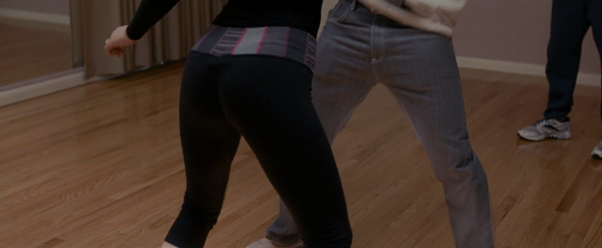

In the climactic dance sequence, a similar technique is used from the perspective of Pat featuring Lawrence crawling on the floor and bending over in front of him, intercut with long shots of the two together on the dance floor. In her essay on fascination with the female Hollywood star, Jackie Stacey discusses two forms of ‘… scopophilia (or pleasure in looking) offered to the spectator …’ (Stacey, 143). One of these is the star being presented as a product within the context of the film, whose body is, to quote Laura Mulvey, ‘… stylised and fragmented by close-up’s …’ (Mulvey, 22). This is evident in the point of view shots featured in both the dancing sequence and Tiffany’s entrance at the start of the film. The second form of ‘… fetishism of the female star …’ (Stacey, 143) is described by Stacey as ‘… the voyeuristic pleasure in the objectification of the female star on the screen’ (Stacey, 143). These are moments when the viewer isn’t aligned with the perspective of a character such as Pat, but instead is made to see Lawrence as attractive and sexualised from an objective rather than subjective state. During dance rehearsals, Pat’s friend Danny (Chris Tucker) says to Tiffany, ‘Girl, you gotta move your junk … Pop your butt.’ This is followed by a shot of Lawrence following Danny’s instructions, which serves no purpose other than to become a ‘… focus of visual pleasure for an apparently masculine spectator’ (Gledhill, xv). As well as objectifying her visually through the cinematography, O. Russell also objectifies Lawrence with regards to the screenplay, where her character is largely embellished in comparison to the novel. For example, Tiffany’s dance sequence takes place roughly half way through the book and is of no consequence, whereas in the film adaptation, it forms the crux of the climax; the happiness and fates of the lead characters depend on the outcome of the dance sequence.
It is evident that Lawrence is presented as a strong, emotionally hardened character in The Hunger Games as well as being objectified as a glamorous celebrity in a satirical mass culture. In a similar way to The Hunger Games, there are two types of objectification occurring with relation to Lawrence in Silver Linings Playbook. The effect of Lawrence’s objectification in the film creates moments of quirky comedy as a consequence of her partially exploited mental trauma which isn’t a trait usually found in conventional romantic comedies. In addition to this, Lawrence is also sexualised and seen as glamorous by both the characters and O. Russell as a director; something which creates a style and tone more typically suited to the Hollywood romantic comedy. A common thread links these types of objectification together: toughness, glamour, quirkiness and sexualisation are all components of Lawrence’s celebrity personality. Thomas Harris believes that ‘… a star is accepted by the public in terms of a certain set of personality traits which permeate all of his or her film roles. The successful stars have been those whose appeal can be catalogued into a series of such traits, associations and mannerisms’ (Harris, 40). Both these films, and many others, serve to enforce the public perception of Lawrence as a glamorous celebrity and therefore, according to Harris, her classification as a successful Hollywood star is justified as her persona is created through these repeated acts of objectification.
Bibliography
Dyer, Richard, Stars (London: British Film Institute, 1979).
Elsaesser, Thomas, The Persistence of Hollywood (New York: Routledge, 2012)
Gledhill, Christine (ed.), Stardom: Industry of Desire (London: Routledge, 1991).
Harris, Thomas, ‘The Building of Popular Images: Grace Kelly and Marilyn Monroe’ in Gledhill (ed.), Stardom: Industry of Desire. ( London : Routledge, 1991 ), pp. 40 – 44.
Kuhn, Annette and Westwell, Guy, Oxford Dictionary of Film Studies (First Edition) (Oxford: Oxford University Press, 2012).
Lodge, David and Wood, Nigel (ed.), Modern Criticism and Theory – A Reader (Third Edition) (Harlow: Pearson Education Limited, 2008).
Mulvey, Laura, Visual and Other Pleasures (London: Macmillan, 1989).
Quick, Matthew, The Silver Linings Playbook (London: Picador, 2009).
Soanes, Catherine and Hawker, Sara (ed.), Compact Oxford English Dictionary – Third Edition (revised) (Oxford, Oxford University Press, 2008).
Stacey, Jackie, ‘Feminine Fascinations: Forms of identification in star-audience relations’ in Gledhill (ed.), Stardom: Industry of Desire. (London : Routledge, 1991), pp. 141 – 163.
Walker, Alexander, Stardom, the Hollywood Phenomenon (London: Penguin, 1974).
Williams, Raymond, ‘Country and City’ in Lodge, Wood (ed.), Modern Criticism and Theory – A Reader (Third Edition). (New York : Pearson Longman, 2008), pp. 339 – 344.
Filmography
The Hunger Games. Dir. Gary Ross, Prod. Lionsgate Films, USA, 2012.
The Poker House. Dir. Lori Petty, Prod. Phase 43 Films, USA, 2008.
Silver Linings Playbook. Dir. David O. Russell, Prod. The Weinstein Company, USA, 2012.
Winter’s Bone. Dir. Debra Granik, Prod. Roadside Attractions, US





